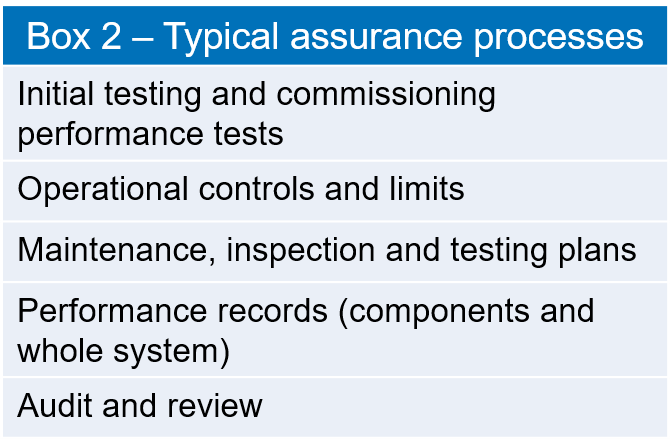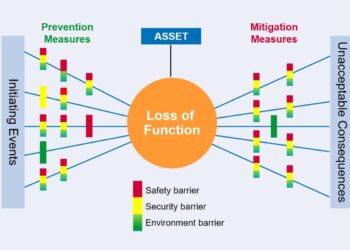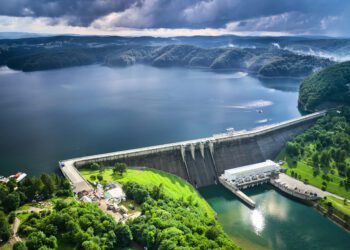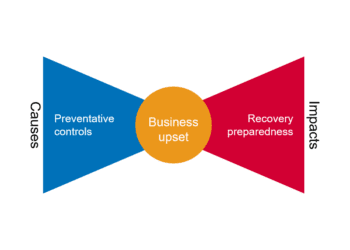Practical fire protection – a risk-based approach
The International Association of Oil and Gas Producers (OGP) recently published a guide to help organizations reduce major incident risks by focusing on asset integrity management [Ref1]. Derived from good practices in mature regions where operators are required to provide structured evidence of sound risk management practices, the guide applies to new and existing assets at all lifecycle stages.
The guide emphasizes the importance of barriers (safeguards or controls) in minimizing the residual risk so far as reasonably practicable. Recognizing that no barrier is infallible, multiple plant and human intervention barriers are put in place to prevent the occurrence of a significant incident. The bow-tie diagram is arguably the best way of illustrating how barriers prevent a hazardous event (the left hand side) and how they mitigate the potential for the event to escalate to the worst case consequences (the right hand side) [see Fig 1].

Figure 1 – The ‘bow-tie’ diagram and the role of fire protection barriers in preventing escalation to a major fire
FIRE PROTECTION BARRIERS
Much design effort is quite rightly focused on prevention – it is better to reduce the inventory of hazardous materials or reliably maintain the integrity of the containment than deal with the consequences of a release. Nevertheless, fire protection barriers have a very important role in preventing and limiting escalation [see Box 1].

DESIGNING TO CODES AND STANDARDS
Fire protection systems are traditionally designed to well known codes and standards, such as the International Building, Fire & Mechanical (ICC) codes, the NFPA codes, and the API fire standards, coupled with sound engineering practice. This approach works very well where there is nothing new or unusual about the design and the risks are well understood. However ,where the design is more novel or challenging, and costs and uncertainty are higher, then the approach is best supplemented by risk-based insights to help avoid over- or under-design.
RISK-BASED APPROACH AND PERFORMANCE
Risk assessment leads to an understanding of the magnitude of fire effects, their likely frequency of occurrence, and the effectiveness of the fire protection barriers in reducing risk. This also leads to the operational performance required for the barriers to meet their intended risk reduction function. High level performance standards are set for each barrier, with more detailed performance standards for constituent parts as appropriate.
Performance standards for barriers are typically described in terms of functionality, availability, reliability and survivability. They thus determine equipment design specifications and also set requirements for maintenance and testing throughout the asset’s lifecycle.
This risk-based approach typically considers a range of possible performance standards for each component – based on recognized design standards – and then optimizes the overall barrier and combined barriers to give the most cost-effective risk reduction.
For example, options to provide increased protection include active fire protection with high installation and maintenance costs but high risk reduction, and passive fire protection with lower costs but shorter lifespan and less risk reduction.
Once performance standards are defined, assurance processes need to be put in place to confirm that barriers remain fit for purpose [see Box 2].

WHEN IS FIRE RISK LOW ENOUGH?
The critical step in deciding when risk has been reduced low enough is to identify a wide range of possible risk reduction measures. Tools are available to help assess the risk, such as barrier analysis, layers of protection analysis (LOPA) and quantitative risk assessment (QRA). In practice any decision amounts to taking a balanced view and reaching a defensible consensus. A convincing justification lies in the documented consideration of risk reduction options, both implemented and discounted, at a level of resolution appropriate to the stage of the facility lifecycle and magnitude of risk.
CONCLUSION
Major fires can have severe consequences for people, the environment, assets and company reputation. The oil & gas industry has been relatively successful in managing these risks, but some high profile major incidents in recent years indicate that the challenge remains. Risk-based fire protection is a powerful but cost-effective way of meeting this challenge.
This article first appeared in RISKworld Issue 15.








